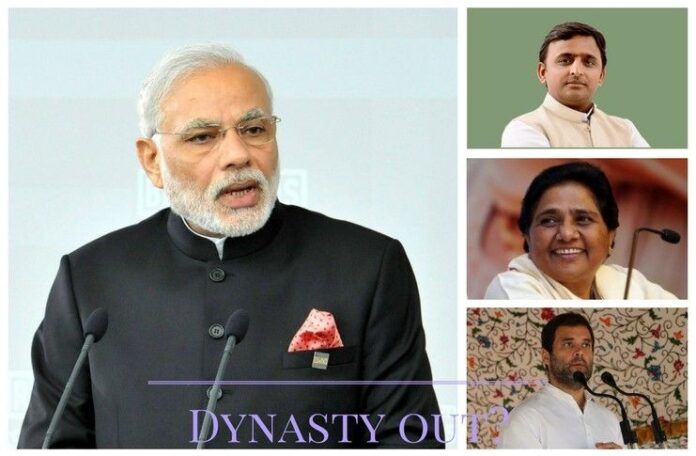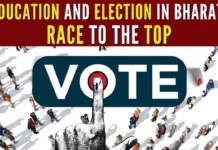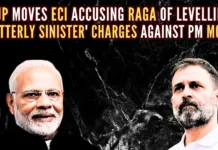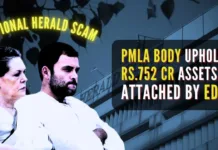
[dropcap color=”#008040″ boxed=”yes” boxed_radius=”8px” class=”” id=””]S[/dropcap]ome elections become defining moments in history. The recent polls in five States, viz., Uttar Pradesh, Uttarakhand, Punjab, Goa and Manipur, were simply scheduled elections, but the Lutyens Secular Brigade invested them with the aura of a referendum on the Modi Sarkar as they happened to coincide with the mid-term of the central government. The media irrationally collated a victory in 2017 with a victory in 2019, though there is no irreversible correlation between the two, and needlessly enhanced the stakes for the electorate, which responded with unexpected vigour.
Uttar Pradesh Chief Minister Akhilesh Yadav was similarly disconnected from the grassroots when he urged cine star Amitabh Bachchan not to advertise the donkeys of Gujarat (Gujarat ke gadhe).
For the media, secular activists, intellectuals and politicians, the elections became a mega version of the ‘maut ka saudagar’ moment when hubris, or sheer lack of credible talking points, led to reckless speech. In the recent presidential elections in the United States, the Democratic Party candidate Hillary Clinton was similarly oblivious of the groundswell in favour of Donald Trump when she belittled his supporters as “a basket of deplorables”; the rest is history. It was later claimed that she got more popular votes, but in the established system in the US, party electoral colleges determine the outcome State by State (which is how she beat Bernie Sanders to get the Democratic nomination).
Uttar Pradesh Chief Minister Akhilesh Yadav was similarly disconnected from the grassroots when he urged cine star Amitabh Bachchan not to advertise the donkeys of Gujarat (Gujarat ke gadhe). This boomeranged because Bachchan was promoting tourism in the Rann of Kutch where the endangered wild ass survives in its last natural habitat, but less aware citizens possibly mistook this to be a slur on the Prime Minister, a former Chief Minister of the State! Who knows? Certainly Narendra Modi gave it this twist by stating that he was proud to work like a donkey for the benefit of the poor.
But such moments apart, the elections indicate a tectonic shift away from the politics of dynasty, from the virtually established tradition that descendants of a political leader(s) can descend on States or constituencies at election time, offer largesse, manage the media narrative, and continue to maintain themselves at the expense of the public exchequer, with zero cost-benefit analysis of the money spent on their upkeep and their service to the people.
[dropcap color=”#008040″ boxed=”yes” boxed_radius=”8px” class=”” id=””]N[/dropcap]ow, with citizens noticing that Prime Minister Modi has not taken a single day off since May 2014, as opposed to persons who need annual vacations and unknown number of secret holidays to secret destinations, the era of accountability has dawned on Indian politics. It is to be hoped that henceforth Members of Parliament will inform the Secretariat of the respective Houses whenever they leave the country, as per rules.
Similarly in Goa, the AAP failed to open its account, so its status as media favourite in these two States certainly needs explanation. There is a huge chasm between supposedly forming the government and failing to open one’s account in a State.
Given the decisive nature of the mandate in three States – BJP won 312/403 seats in Uttar Pradesh (the coalition won 325) and 57/70 in Uttarakhand, and Congress under Captain Amrinder Singh secured 77/117 seats in Punjab (it was his victory) – there can be no excuse for the media failure to predict even the general trend of the elections. The Aam Aadmi Party’s over-hyped ‘victory’ in Punjab materialised as 20/117, not bad for a newcomer and ahead of the SAD-BJP combine, but nowhere near the media projections. Similarly in Goa, the AAP failed to open its account, so its status as media favourite in these two States certainly needs explanation. There is a huge chasm between supposedly forming the government and failing to open one’s account in a State.
The hung assembly predicted for Uttar Pradesh actually materialised in Manipur (Congress 28/60, where BJP made decisive inroads 21/60) and Goa (where BJP slipped 13/40 and Congress gained 17/40); independents will now dictate the final outcomes here. At the time of going online, Manohar Parrikar has staked claim to form the government in Goa, with the support of the non-Congress parties.
Analysing the trends in UP, it is obvious that the BJP enjoyed spectacular success in all stages. Whereas the media projected the Samajwadi Party-Congress combine as victors in the first two stages, the BJP actually won 115/125 of these seats; when party president Amit Shah claimed the BJP would win 90/125, he was greeted with bemused silence, but the results vindicated his homework.
[dropcap color=”#008040″ boxed=”yes” boxed_radius=”8px” class=”” id=””]T[/dropcap]here is much scepticism about the Union Government’s pro-poor and pro-development schemes impacting lives at grassroots level, but it is undeniable that the negative impact expected from Demonetization did not materialise in favour of the BJP’s opponents. On the contrary, the BJP dramatically improved upon its performance in the 2014 Lok Sabha polls, where it won 73/80 along with its ally, the Apna Dal.
The BJP avoided chasing the Muslim-Yadav (SP-Congress) and Jatav-Muslim (BSP) votebank by not fielding a single Muslim candidate (something it has already indicated it will not do again), but appealed for votes on a development plank.
Amit Shah’s strategy of building a broad coalition of castes generally neglected by the Samajwadi Party, Bahujan Samaj Party, and Congress, was hugely successful, as was his experiment with selectively inducting outsiders into the party, and taking the risk of not declaring a Chief Minister candidate. This, despite the fact that the absence of a candidate was believed to be partly behind the rout in Bihar.
The BJP avoided chasing the Muslim-Yadav (SP-Congress) and Jatav-Muslim (BSP) votebank by not fielding a single Muslim candidate (something it has already indicated it will not do again), but appealed for votes on a development plank. It further dented the Muslim votebank of its rivals by pointing to developmental projects taken up on communal lines (the famous kabristan-shamshan statement by the Prime Minister and the KASAB acronym for Congress-SP-BSP by Amit Shah) and made a killing by promising to take up the issue of triple talaq in favour of Muslim women who are now extremely agitated over the issue, nationwide. Little wonder that the party romped to victory even in Deoband, where media reports state that the electorate is 80 per cent Muslim. This clearly indicates that a section of the community voted for the BJP.
In terms of electoral arithmetic, the BJP is said to have allocated nearly 150 seats to non-Yadav OBCs in UP. Its alliance with the Apna Dal and Suheldev Bharatiya Samaj Party helped consolidate non-Yadav OBC groups like the Patels, Kurmis and Rajbhars. Unlike in Bihar, it changed its star campaigners in all seven phases of the polls and featured, besides the Prime Minister and Amit Shah, leaders like Rajnath Singh, Keshav Prasad Maurya, Kalraj Mishra and Uma Bharti. Newcomers with winning chances were given 100 tickets, a huge gamble that paid off.
[dropcap color=”#008040″ boxed=”yes” boxed_radius=”8px” class=”” id=””]T[/dropcap]he opposition claim, resting on media accounts of the distress caused by demonetization, turned out to a damp squib. Modi hardly mentioned it in his rallies, and anyway, BJP had used it in the civic polls in Chandigarh, Gujarat and Maharashtra and Panchayat polls in Odisha, to claim success in bringing unaccounted money into the banking system.
As for Akhilesh Yadav, he always knew that the communal tensions in Muzaffarnagar that gave BJP its massive victory in 2014, were continuing to fester in many areas of the State and were affecting his own vote base.
Actually, a Bihar-style Mahagathbandhan should have included the BSP, but Mayawati was left out of the SP-Congress talks, whereas, as Akhilesh Yadav indicated when he realised that he was likely to lose, she would have been a better bet than the Congress Party. Also, the main focus of the SP-Congress alliance, and their friendly media, was that the anti-BJP alliance was enough to decimate the rival. This kind of alignment of hate did not go down well with the people, who took it as an affront to be told that voting for the BJP amounted to being communal, un-secular, etc.
For non-BJP parties this is a major reality bite, a warning to rewrite their old, tired scripts. Media, too, will have to introspect upon its mindless demonization of the BJP since the early 1990s. A three-fourths majority cannot be easily scoffed.
As for Akhilesh Yadav, he always knew that the communal tensions in Muzaffarnagar that gave BJP its massive victory in 2014, were continuing to fester in many areas of the State and were affecting his own vote base. But he did nothing about the situation and mistakenly banked upon the Congress to bridge the social divisions, which turned out to be a big mistake. The 105 seats given to Congress yielded low dividends (7) and dragged the alliance down. The voter base of both parties proved non-transferable.
[dropcap color=”#008040″ boxed=”yes” boxed_radius=”8px” class=”” id=””]T[/dropcap]he unkindest cut was the defeat of the Mulayam Singh Yadav’s daughter-in-law Aparna Yadav, who made her political debut in these elections. She lost to Rita Bahuguna Joshi (who left Congress for the BJP) by a convincing margin (33,000 votes).
The BSP crisis is equally deep, but it is a one-woman party and its voters have many options.
For Congress, both Rahul Gandhi and Priyanka Gandhi have proved to be non-bankable stars, and the party is the worst sufferer of the recent polls. Its prospects in 2019 look dim. Sonia Gandhi is unlikely to contest another election, and if Priyanka Gandhi contests from Rae Bareli and loses, and Rahul Gandhi loses in Amethi (BJP won 6/10 Assembly seats in both constituencies by big margins), it is sundown for the country’s most famous dynasty. Worse, the Gandhi scions will not be able to find States that can send them to the Rajya Sabha, an indication of the erosion the popular support for the party across the country.
As Captain Amarinder Singh can be expected to carve out an independent path at some stage, it is a safe bet that all Congress leaders with local support bases would be rethinking their future. The BSP crisis is equally deep, but it is a one-woman party and its voters have many options.
The Media is the giant loser of the election. As former Jammu & Kashmir Chief Minister Omar Abdullah said, the pro-BJP trend in UP was not a ‘wave’ but a ‘tsunami’, yet none could discern it. This is a credit to the management abilities of the Lutyens Brigade, where opinions were given more weight than facts. Only, it never expected Nemesis to be so close on its heels! No excuse will be good enough to explain the utter non-professionalism of the Indian media, whose lack of credibility has now been noted by its friends across the world.
- Plagiarism with Pride - November 10, 2018
- “Hindu-ness is the essence of India” – RSS Sarsanghachalak - September 20, 2018
- Lacunas persist in Kathua story - May 5, 2018











Couldn’t agree more on every single observation of this very insightful analysis. As Sandhyaji rightly says, the media openly bats for anybody who is willing to challenge the ruling BJP government. It’s very brazen and unhinged. And it does appear that there is a sense of helplessness and deep resentment in the media that the opposition is not matching up. Anyways, enjoyed reading Sandhyaji’s analysis and waiting for more to come.
Last but not the least Sir, An excellent article by the devoted daughter of a great editor of Times of India. Kudos to Madam Sandhya jain.
A clear cut victory for truth honesty ,integrity,and above all Patriotism of the highest order. India,my motherland has at last found her son to heal her wounds,and nurse her back to health although it may take time given elements like Shiv Sena,( Ruckus in Parliament to day), Dravidian parties of T.N,Trinamool Mamata and the remains of communism and of course the the looting dynasty of Gandhis. We have a huge task on hand to lock up the criminals which our one man army of Dr swamy will effectively take care off. As Robert Forst has said “we have miles to go before we can sleep. God bless my beloved Motherland. Ganesh.
Nice Analysis .
It is nice to see some of the wtiers denied space in the conventional media are finding opportunity to express their views in the Social media and the public is getting more hidden information and better analysis. It is really nice to see that PM never took single day leave. Worth noting.
It is a great article on this subject post BJP stunning show in UP. It goes without saying that Narendra Modi’s leadership has transformed the BJP. It’s no more the BJP of 2012. Today’s BJP is aggressive and assertive. The charisma of the prime minister, when added to the well-oiled BJP organisational machinery, works like magic. Apart from his leadership skills, the attribute that sets him apart is his oratory. He makes an instant connection with his audiences. The charisma of the Modi, when added to the well-oiled BJP organisational machinery, works like magic.After 2014, it has worked in many states. In UP too, brand Modi has paid rich electoral dividends.
The first masterstroke of BJP president Amit Shah in Uttar Pradesh was to pick up the relatively unknown Keshav Prasad Maurya as state unit head.He belongs to the Kushwaha-Maurya caste. It is one of the largest backward castes in UP, the others being Yadav, Kurmi and Lodh.This has helped the party replicate Kalyan Singh’s formula of giving leadership to Non-Yadav OBCs and add it to their core upper caste vote.
The tsunami in favour of BJP would not be easy for its rivals to swallow. That is why Mayawati has already started blaming the EVM machines for the landslide victory of the BJP. But then, who cares for her. She has been rejected by the people time and again. She is a spent force. She must understand that.
It is an outstanding article and you have discussed the subject very nicely. It is indeed the best article i have read on this subject. I feel that Modi’s leadership has transformed the BJP. It’s no more the BJP of 2012. Today’s BJP is aggressive and assertive. The charisma of the prime minister, when added to the well-oiled BJP organisational machinery, works like magic. Apart from his leadership skills, the attribute that sets him apart is his oratory. He makes an instant connection with his audiences. The tsunami in favour of BJP would not be easy for its rivals to swallow. That is why Mayawati has already started blaming the EVM machines for the landslide victory of the BJP. But then, who cares for her. She has been rejected by the people time and again. She is a spent force. She must understand that.
Very nice analysis. It exposes the uncouth people claimed as Liberals or whatever name etc
Analysed so well. Post independence this is the second round of freedom from “Rajwadas (kingdoms)”. First was from actual kings and now from the Dynastic Fiefdoms which are born due to crony politics of India.
Remember Bihar, Nitish Kumar took umbrage to NaMo’s DNA comment who squeezed it by twisting it to mean all Biharis, and RSS chief’s review of reservation to mean end of it; got political dividends from casteist voters.
Why not PM Modi use the ‘gadha’ remark to his advantage.
Great article from Sandhya. Must be read by all.
I would support NaMo even if he had declared only a one point agenda- scamgress mukth Bharath! But he is offering more- development and probity in public life! I am waiting for the day when the looters of the nation are tucked away in solitary confinement in Tihar!